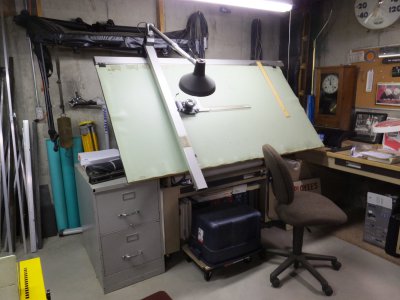Like many here I started with a drawing board and T square. In the business world the T square was replaced by a drafting machine, and the board was replaced by a drafting table and return. Our floor of the office building was designed to accommodate 40 engineers with 48" x 72" Mayline drafting tables and return desks. The cubicles were huge compared to most other departments.
As time went on the company switched to CAD. The first system was Auto-trol. It was a mainframe system utilizing dumb terminals. When the company switched from the mainframe to PC's we changed to AutoCad. The drafting tables, machines and other support equipment were slowly moved to storerooms and eventually donated to technical colleges. After a few years the colleges also started switching to software-based drawing programs so the equipment that was formerly donated was either sold to employees or trashed.
When it came time to give up my equipment I asked if I could purchase it. The answer was yes, and that for $50.00 I could have the table, machine, light, and return desk. Since it was the last manual drafting equipment in the department, I could also have all the remaining supplies. The supplies included hundreds of boxes of different leads, automatic pencils, erasers, triangles, different scales for the machines, and tons of other stuff long forgotten. I took everything home and set it in the corner of the basement. The drafting table became a catch all for anything and everything. You'd be surprised how much weight one of those tables can actually handle.
When I retired, I still retained the rights to the AutoCad system on my computer. I could take the software (in CDs at the time) and install it on my home computer. That worked fine for a couple years, but eventually the lease ran out and I had to either renew it for $1,000.00 a year or find something new. For the small amount of drafting, I was doing I didn't feel it was worth the money to renew the lease. Instead, I cleaned all the junk off the drafting table and started using it. I'm sure there are less expensive drafting programs out there today. However, I actually enjoy sitting down at the table and drawing a part manually.
As for engineers not being in touch with the end results of their designs, the company I worked for was just the opposite. When an engineer was hired, they were assigned to one or more machine design projects. Those projects would be their responsibility for the entire time they were with the company. If an original design didn't work out well, they had to make the needed improvements to satisfy the productivity, ergonomics, safety, maintenance requirements, or any other short comings of the original design.
In the future should the company decide the machine output needed to be increased the original engineering team would be responsible for making it happen. There was no such a thing as passing a poor design on to the production staff and running off to a new project. I was involved with a number of projects and followed them through until I was asked to transfer to a different department.
Even after 10 years in the new department I was asked to revisit one of the original projects. This time the machines had been in service for many years, and it was time to rebuild them from the ground up. We setup a 2-year project to rebuild machines in a shop in a small town in Iowa and convinced 2 of our best technicians to switch from a maintenance capacity to machine rebuilders. As part of the project, with each machine, we brought in 2 technicians from the production facility for training. We also wrote a training manual covering all phases of the rebuild process to be used as a reference for future maintenance and upgrades.
When the project wrapped up, we had rebuilt 62 machines from the ground up and trained over 100 technicians on how to maintain, repair, and rebuild the machines as necessary. Over 25 years later I'm sure the machines have been replaced by newer and faster technology and most of the technicians are probably retired. Non the less I'm sure it was a worthwhile investment for the company.
Here's a picture of my old drafting board setup. It still gets used today. It's a bit hard to see, but the picture on the desk is of my father-in-law inspecting a section of machinery he designed in the 1950's. He worked there from 1954 to 1985. In the 30+ years he was there the machines he designed remained his responsibility.




